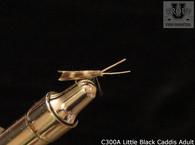
The Frying Pan River is one of the most favorite tailwaters in all of the country because of its beauty and accessibility, but most of all, because of the giant trout that can be caught in the 14 mile section below Ruedi Reservoir Dam. It is said that the Frying Pan River got its unusual name from a legend about a frying pan left in the crotch of a tree to mark the spot where a brave companion had fallen in a fight with the Indians. The “Pan” as it is often called, originates east of Aspen Colorado in the Hunter Fryingpan Wilderness. It flows northwest to the Ruedi Reservoir and then continues to meet with the Roaring Fork at Basalt. As the Frying Pan flows toward its confluence with the Roaring Fork River, it passes through a beautiful canyon lined with red sandstone and evergreen trees which can be seen in the picture above. It is a cold river and has abundant year around hatches of aquatic insects perfect for fly fishermen.
Fly Fishing the Frying Pan:
The upper headwaters and tributaries above the Ruedi Reservoir are freestone streams and depend on the snow melt for their supply of water. The headwaters consist mostly of pocket water populated with small rainbows, cutthroat and brook trout. While these trout average a little smaller, they do provide a good deal of fun and with less pressure.
The main attraction of the Frying Pan River, however, is its population of huge rainbow trout. Rainbows have been caught weighting over ten pounds. The secret to creating these huge rainbow trout below the dam is believed to be the mysis shrimp, a small freshwater shrimp that is stocked in the lake. The shrimp that get through the dam provide a feast for the rainbows. The area just under the dam is called the toilet bowl. Fishing in this area can be very crowded with anglers every few feet. However, fishing a little lower in the Pan will result in far less pressure. The first few miles below the dam is usually fairly fast moving water consisting of riffles, runs and pools. As the stream flows downstream, it slows down and widens out averaging about 50 feet in width. The nice feature of the entire tailwater section of the Frying Pan River is that is designated as Gold Medal. The regulations for the Gold Medal designation are artificial flies and lures only, catch and release for all fish except the browns, and the browns over 14 inches must be released immediately.
Spring:
We feel that the best time to fish the Frying Pan is in late winter and early in the spring when the discharges are low permiting sight fishing. You can target individual trout during this time providing a great deal of excitement. The Blue Winged Olives hatches will start around the first of February and continue through March. The huge salmon flies will start to hatch around the first of May and last until late in May.
Summer:
There are several species of Caddisflies on the Frying Pan and the Spotted Sedges hatch from June through September. The Little Sisters will hatch in July and don't forget the plentiful Green Sedges (Green Rock worms). Starting in early July, the Pale Morning Duns will hatch and that hatch will continue through to the first of September. The Western Green Drakes will be hatching about the same time. Terrestrials including beetles, ants and hoppers will work well in the summer as well.
Fall and Winter:
Starting in July and August the Little Yellow Stoneflies (Little Sallies) will be hatching. The October Caddis will be hatching starting in September and going through October. The Blue Winged Olives are bi-brooded and the second brood will start in August and continue through November. Also, streamers and imitations of the Mysis shrimp will prove effective. The Pan can be fished in the winter since it never freezes over due to the bottom discharge from the dam. When it is cold, go with the sculpin imitations and the Midge imitations since some other foods may not be as plentiful. Since it close to Aspen, while not get in some fly fishing as well as skiing.
There is a good deal of public access to the Frying Pan River especially below the dam where some 8 miles or more are accessible. Fishing is available in the town of Basalt at Strawberry Rock. The upper portion of the Pan, from the White River National Forest to the Ruedi Dam, there are three campgrounds.
Frying Pan River Colorado Hatch Chart
The hatches discussed in the report above are based on actual stream samples and we feel that they are accurate. Also, unlike generic flies as sold by most fly shops, our Perfect Flies are exact imitations of the actual aquatic insect so why not increase your chances by using them.





